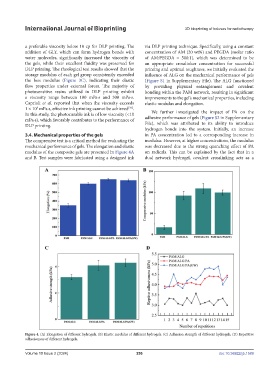Page 264 - IJB-10-2
P. 264
International Journal of Bioprinting 3D bioprinting of boluses for radiotherapy
a preferable viscosity below 10 cp for DLP printing. The via DLP printing technique. Specifically, using a constant
addition of GLY, which can form hydrogen bonds with concentration of AM (20 wt%) and PEGDA (molar ratio
water molecules, significantly increased the viscosity of of AM:PEGDA = 500:1), which was determined to be
the gels, while their excellent fluidity was preserved for an appropriate crosslinker concentration for successful
DLP printing. The rheological test results showed that the printing and optimal toughness, we initially evaluated the
storage modulus of each gel group consistently exceeded influence of ALG on the mechanical performance of gels
the loss modulus (Figure 3C), indicating their elastic (Figure S1 in Supplementary File). The ALG functioned
flow properties under external forces. The majority of by providing physical entanglement and covalent
photosensitive resins utilized in DLP printing exhibit bonding within the PAM network, resulting in significant
a viscosity range between 100 mPa·s and 300 mPa·s. improvements to the gel’s mechanical properties, including
Caprioli et al. reported that when the viscosity exceeds elastic modulus and elongation.
1 × 10 mPa·s, effective ink printing cannot be achieved .
3
[36]
In this study, the photocurable ink is of low viscosity (<10 We further investigated the impact of PA on the
mPa·s), which favorably contributes to the performance of adhesive performance of gels (Figure S2 in Supplementary
DLP printing. File), which was attributed to its ability to introduce
hydrogen bonds into the system. Initially, an increase
3.4. Mechanical properties of the gels in PA concentration led to a corresponding increase in
The compressive test is a critical method for evaluating the modulus. However, at higher concentrations, the modulus
mechanical performance of gels. The elongation and elastic was decreased due to the strong quenching effect of PA
modulus of the composite gels are presented in Figure 4A on radicals. This can be explained by the fact that in a
and B. Test samples were fabricated using a designed ink dual network hydrogel, covalent crosslinking acts as a
Figure 4. (A) Elongation of different hydrogels. (B) Elastic modulus of different hydrogels. (C) Adhesion strength of different hydrogels. (D) Repetitive
adhesiveness of different hydrogels.
Volume 10 Issue 2 (2024) 256 doi: 10.36922/ijb.1589

